EL HIERRO
Society

Society
Popular destinations SPAIN
| Andalusia | Catalonia | Costa blanca |
| Costa brava | Costa del sol | El hierro |
| Formentera | Fuerteventura | Gran canaria |
| Ibiza | La gomera | La palma |
| Lanzarote | Mallorca | Menorca |
| Tenerife |
Society
State structure
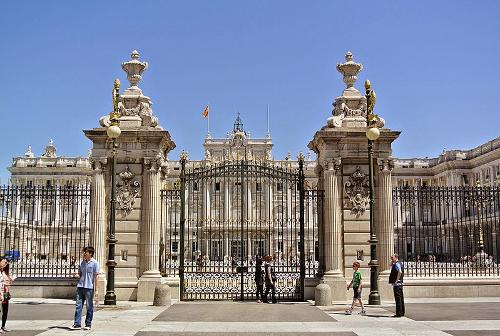 Cortes SpainPhoto: Ben Bender CC 3.0 Unported no changes made
Cortes SpainPhoto: Ben Bender CC 3.0 Unported no changes made
On November 22, 1975, Spain became a parliamentary constitutional monarchy again. The constitution is based on the constitution (Constitución) which was approved on December 6, 1978 after a referendum. The large degree of autonomy of the different peoples and regions was also regulated by this.
The Spanish Parliament, the "Cortes Generales", consists of the Congress of Deputies (Congreso de los Diputados), and the Senate (Senado). These two chambers are called together by the king and can also be dissolved by him. Only the Congreso can force the government to resign after a vote of no confidence, a "moción de censura".
The 350-member Congress is elected for four years. The provinces form the electoral districts and the enclaves of Ceuta and Melilla in Morocco are each represented in Congress by one delegate. The Spanish electoral system is a combination of a district system and proportional representation. All Spaniards aged eighteen and older are allowed to vote.
The Senate has 255 members, regional deputies with a term of four years and almost every province can appoint four senators. As a result, the vote of the smallest province is just as important as the vote of the largest province. This is not considered a good course of events and therefore plans to change the whole set-up of the Senate. The intention is that the Senado will become the representation in the government of the autonomous regions, and therefore no longer of the provinces. For the time being, however, that are no more than plans.
After a draft government program has been drawn up, Congress elects the Prime Minister (Presidente del Gobierno). At the proposal of the Prime Minister, the King can appoint or dismiss ministers. The Prime Minister is very powerful in Spain and can be compared to the British Prime Minister or the German Chancellor. The Spanish ministers may also be members of parliament.
After Congress has given its consent, the king, on the proposal of the prime minister, can call a referendum. These referendums are purely of a consultative nature. For the current political situation see chapter history.
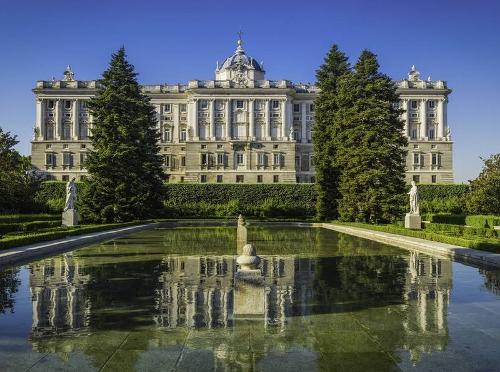 Royal palace, SpainPhoto: Rodrig RM CC 4.0 International no changes made
Royal palace, SpainPhoto: Rodrig RM CC 4.0 International no changes made
Spain's hereditary head of state is the king, the "Rey de España", also the symbol of unity. The person of the king is inviolable and takes no responsibility whatsoever. All decisions of the king are therefore countersigned by the Prime Minister. Thus, the ultimate responsibility always rests with the person who signs the decisions.
The king has so many, albeit formal powers, that he has a great influence on a number of important matters.
Some of its powers are:
- Enacting laws.
- He organizes referendums and elections.
- He appoints and dismisses ministers on the recommendation of the prime minister.
- He is Commander in Chief of the Armed Forces.
- He can pardon.
Administrative division
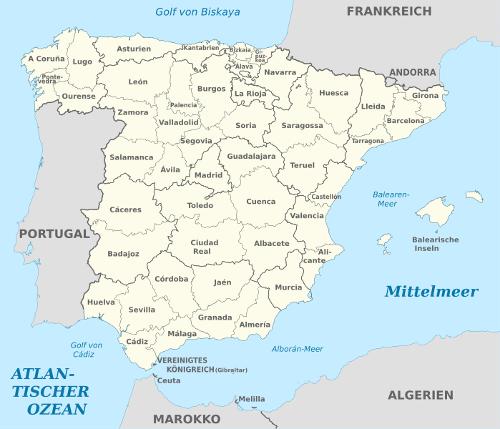 Spain Administrative divisionPhoto: TUBS CC 3.0 Unported no changes made
Spain Administrative divisionPhoto: TUBS CC 3.0 Unported no changes made
Spain had a highly centralized form of government under the dictator Franco. In 1978, the form of government changed into a decentralized structure with seventeen autonomous regions (comunidades autónomas), each with its own president, parliament, executive and supreme court. Spain is composed at a lower level of 52 provinces, including the enclaves of Ceuta and Melilla in Morocco, which in 1995 were declared "Ciudad Autónoma", autonomous cities with limited powers. These provinces are governed by provincial councils (Diputaciones Provincial). The members of the provincial council are elected from among their number following municipal elections by the councilors in the province. The executive committee of the provinces is the "Comisión de Gobierno".
The municipalities (municipios) are governed by mayors and councilors (Ayuntamiento). The mayors are elected by the councilors and the councilors are elected by the residents of the municipalities. In 1998 there were 8 097 municipalities in Spain. Spain has many very small municipalities, sometimes with less than 100 inhabitants. Approx. 86% of all municipalities have less than 500 inhabitants. Some small municipalities have a so-called "Asamblea Vecinal" in which all residents form a kind of neighborhood council that takes the decisions.
On December 18, 1979, Catalonia and the Basque provinces were the first to have a form of self-government. The Basque population elects a Basque National Council that has many powers in matters such as trade, agriculture, education and health care. This National Council elects a prime minister who then forms a government. There is even a fiscal autonomy that allows people to levy taxes themselves.
A parliament is elected in Catalonia. This parliament itself elects the prime minister and the government.
The parliament, the president and the government collectively bear the historical name "Generalitat" (Generality). The competences lie in the fields of education, tourism, energy supply, media and financial institutions. The Generality can levy taxes itself and, just like in the Basque provinces, Catalonia has its own police force.
Education
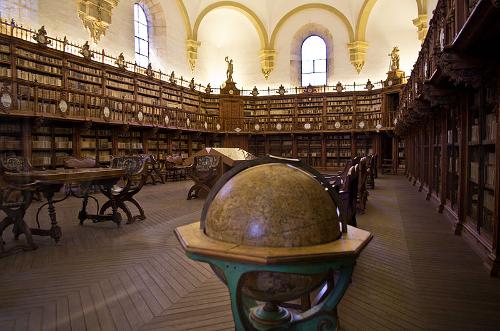 Library of the University of Salamanca, SpainPhoto: Antoine Taveneaux CC 3.0 Unported no changes made
Library of the University of Salamanca, SpainPhoto: Antoine Taveneaux CC 3.0 Unported no changes made
Education in Spain has long lagged behind the rest of modern Europe. Especially the countryside, where the distances are great and the connections were poor, had a large number of illiterate people. The money spent on education also contrasted sharply with other countries in Europe. The change started from 1962 under the Franco regime. In barely fifteen years, the budget for education has increased by 100%. Illiteracy, especially among the elderly, was tackled by the Servicio de Educación Permanente de Adultos. This organization provides lower education courses for the elderly. Moreover, control over education is in the hands of the autonomous governments. Distance education, the Educación de Distancia ", also ensures that more and more people can make use of the education system, and that applies to primary to university education. In 1999 more than 130,000 people followed university education in this way through the Universidad Nacional de Educación de Distancia, which even has branches abroad.
One-third of the pupils attend private schools owned by private or religious people. Most of these schools are 100% funded by the government. They are then obliged to have a school board and in principle to admit any student. Education at the state schools is free.
According to the new education law of 1990, the Ley Orgánica de Ordenación General del Sistema Educativo (LOGSE), there are the following school types in Spain:
First of all, the Educación Infantil, pre-school and kindergarten. This non-compulsory education consists of a three-year or six-year cycle.
This is followed by Educación Primaria, the primary education that is provided from six to twelve years of age and is compulsory. There are three cycles of two years each with a number of compulsory and a number of optional subjects. The introduction of a foreign language is already started in group three.
Compulsory secondary education is the Educación Secundaria Obligatoria (ESO), from 12 to 16 years old, after which compulsory education ends. The ESO has two two-year cycles. The second cycle contains most of the courses taught in the first cycle, supplemented with a number of electives that increase to 30%.
After the ESO, the pupils receive a certificate that gives access to the "Bachillerato". One can also study in vocational training.
The Bachillerato gives access to the university. One gets compulsory core subjects and subjects of the direction one chooses: engineering, art, natural sciences or social sciences. In addition, there are again a number of electives.
Secondary vocational education, the Formación Profesional Grado Medio, is not very popular in Spain. It takes an average of about two years and the students, in addition to general subjects, mainly receive vocational subjects.
Higher professional education or Formación Profesional Grado Superior can be followed with a Bachillerato diploma.
University education is divided into three cycles:
After the first three years one is "Diplomado" and with that obtained diploma the second cycle can be followed, which lasts two years. One is then a "Licenciado", roughly comparable to "master's degree". After this one can continue studying for the title of "Doctor".
Spain currently has 62 universities, 19 of which are private. The University of Salamanca is the oldest in Spain and dates back to 1218. The Universidad Complutense of Madrid/ Alcalá is one of the largest in the world with more than 100,000 students. Other major universities are those of Barcelona, Valencia, Seville, Granada and País Vasco. The number of university students has doubled in ten years to more than 1.5 million in 1999.
Healthcare
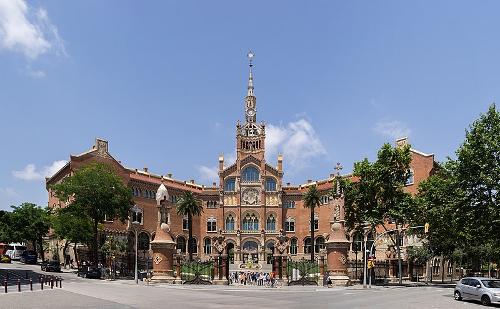 Hospital Sant Pau, Barcelona, SpainPhoto: Thomas Ledl CC 4.0 International no changes made
Hospital Sant Pau, Barcelona, SpainPhoto: Thomas Ledl CC 4.0 International no changes made
In Spain, a lot of money is traditionally spent by the government on healthcare. A number of autonomous regions regulate healthcare themselves. The Compulsory Health Insurance, set up in 1942, was very inadequate, and it was only after the Seguridad Social was set up in 1966 that much changed for the better. In 1971, 75% of the population was already covered by this scheme and by 1982 that percentage had already risen to 86%. In 1986 the Ley General de Sanidad was adopted, making it possible to house the entire population in the Sistema Nacional de Salud, the National Health System. From 1991, 99% of the Spanish population is covered by this system. There are plans to privatize this scheme.
Spain also has a large number of private clinics. Approx. 25% of medical care is provided in private clinics and other private institutions.
Due to the much improved medical care, it is currently among the best in the world. The life expectancy of the population is therefore very high and the infant mortality is very low. The number of doctors per 1000 inhabitants and the number of organ transplants per million inhabitants are also among the highest in the world.
Typical for the Canary Islands
Lucha Canaria
Lucha Canaria is a Canarian 'Guanche' wrestling sport practised only in these islands. Twelve wrestlers ('luchadores') from two teams compete in pairs in a circle (15 metres in diameter) delimited by sawdust. The aim is to use certain moves to bring the opponent to the ground within three minutes. Whoever wins two out of three matches wins.
Other traditional sports are stick fencing or 'juego de palo', cock fighting, mast climbing and long jumping with a lance.
Gofio
Gofio is the oldest surviving staple food of the Canarian primitive people. This highly perishable dish consisted of flour made from barley grains, but nowadays only from maize. Gofio is still sold in supermarkets, but is not so common on the menu in traditional restaurants.
Sources
Evers, K. / Canarische Eilanden : Tenerife, La Gomera, El Hierro, La Palma, Gran Canaria, Fuerteventura, Lanzarote
Gottmer
Leibl, M. / Gomera & Hierro
Van Reemst
Lipps, S. / Wandelgids La Gomera en El Hierro
ANWB
Murphy, P. / Canarische Eilanden
Kosmos-Z&K
Renouf, N. / Canarische Eilanden
Kosmos-Z&K
Rochford, N. / Wegwijzer voor La Palma en El Hierro : een landschapsgids
Sunflower Books
CIA - World Factbook
BBC - Country Profiles
Copyright: Team The World of Info